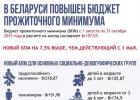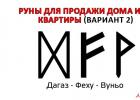From August 1, 2017 in Belarus (based on the Resolution of the Ministry of Labor and Social Protection of the Republic of Belarus dated July 24, 2017 No. 32), a subsistence level budget was established on average per capita and for the main socio-demographic groups of the population in June 2017 prices based on for a month .
In accordance with the Resolution of the Ministry of Labor and Social Protection of the Republic of Belarus dated July 24, 2017 No. 32, the subsistence level budget was established on average per capita and for the main socio-demographic groups of the population in prices of June 2017 per month for the period from August 1 until October 31, 2017 in the following sizes:
on average per capita – 197 Belarusian rubles 57 kopecks;
working population – 218 Belarusian rubles 87 kopecks;
pensioners – 151 Belarusian rubles 98 kopecks;
students – 192 Belarusian rubles 79 kopecks;
children under three years of age – 125 Belarusian rubles 87 kopecks;
children aged three to six years – 174 Belarusian rubles 90 kopecks;
children aged six to eighteen years – 215 Belarusian rubles 50 kopecks.
Text Resolution of the Ministry of Labor and Social Protection of the Republic of Belarus dated July 24, 2017 No. 32 officially published on the National Legal Internet Portal of the Republic of Belarus. The resolution comes into force after its official publication.
What is the cost of living budget in Belarus?
To put it as simply as possible, then BPM is the amount of money on which, in the opinion of the state, a person can survive. BPM, like minimum consumer budget (MCB), approved by the Ministry of Labor and Social Protection of Belarus every quarter. BPM has a direct impact on the amount of child benefits and assistance to low-income citizens and families. BPM is also used as a basis for calculating the minimum amount of old-age pensions, scholarships, and benefits. BPM already have ideas MPB, since it does not include costs for cultural and educational events and recreation. Thus, BPM And MPB Although the concepts are similar, they should not be confused.
In Belarus subsistence budget the average per capita (BPM) in June prices of the current year per month will be from August 1 to October 31, 2017 Br197.57. This decision is contained in the resolution of the Ministry of Labor and Social Protection dated July 24, 2017 No. 32, the relevant department reported.
The new BPM increased by 7.5% compared to the standard in force from May 1 to July 31 of this year (Br183.82). This is due to rising prices for fruits and vegetables of the new harvest and the significant share of this item of expenditure in food products.
In connection with the change in the BPM, minimum labor and social pensions will increase from August 1, 2017; bonuses, increases in pensions and additional payments to persons aged 75 years and older who receive pensions from the labor, employment and social protection authorities; benefits for caring for a disabled person of group I or for a person who has reached 80 years of age; as well as state benefits for children: at the birth of the first child - 10 BPM, for the second and subsequent children - 14 BPM; for caring for a disabled child under 18 years of age - 1 BPM; for children aged 3 to 18 years during the period of raising a child under 3 years of age - 0.5 BPM; for children over 3 years of age from certain categories of families (0.5 BPM, 0.7 BPM), for children under 18 years of age infected with the human immunodeficiency virus (0.7 BPM).
In accordance with the resolution of the Ministry of Labor and Social Protection, from August to October of this year the BPM of the working-age population is Br218.87 (from May 1 to July 31 - Br204.35); pensioners - Br151.98 (now - Br141.50); students - Br192.79 (Br178.66); children under three years of age - Br125.87 (Br119.55); children aged three to six years - Br174.9 (Br163.83); children aged six to eighteen years - Br215.5 (Br201.05).
According to experts, the BPM serves as a standard for indexing the population’s income and acts as a criterion of need in determining the right of citizens to state targeted social assistance (GASP) in the form of a monthly social benefit and provision of food for children in the first two years of life. In addition, the subsistence level budget is used to calculate other payments and serves as an assessment criterion in determining the right of citizens to certain types of social support.
National legislation defines the legal basis for the concept of a living wage and its use. Thus, the subsistence budget represents the cost value of the minimum set of food products and non-food goods and services necessary to maintain human health and ensure his life, the cost of which is determined as a fixed share of the cost of the minimum set of food products, as well as mandatory payments and contributions. The subsistence level for the main socio-demographic groups of the population consists of a minimum set of food products, non-food products and services (their cost is determined at 77% of the cost of a minimum set of food products).
In Belarus, the cost of living budget will increase from November 1. It will increase by 0.3% - to 214.21 rubles. This is provided for by Resolution of the Ministry of Labor dated October 26, 2018 No. 79.Following the BPM, one-time benefits for the birth of children will also increase.
The photo is for illustrative purposes only. Photo: Dmitry Brushko, TUT.BY
The Ministry of Labor clarifies that the size of the subsistence level budget on average per capita and for the main socio-demographic groups (in prices of September 2018 this year) from November 1 will be:
- working-age population - 237 Belarusian rubles 21 kopecks;
- pensioners - 163 Belarusian rubles 93 kopecks;
- students - 207 Belarusian rubles 30 kopecks;
- children under three years of age - 139 Belarusian rubles 79 kopecks;
- children aged three to six years - 191 Belarusian rubles 9 kopecks;
- children aged six to eighteen years - 233 Belarusian rubles 56 kopecks.
In connection with the change in the BPM, from November 1, minimum labor pensions, social pensions, and additional payments to pensioners aged 75 years and older who receive pensions from labor, employment and social security agencies will also increase. Supplements to pensions and increases in pensions for certain categories of pensioners, benefits for caring for a group I disabled person or for a person who has reached 80 years of age and the amount of state benefits for families raising children will also change.
The new BPM size will be valid until the end of January 2019.
In proportion to the growth of the BPM, the amounts of some child benefits will also change. Thus, a one-time benefit in connection with the birth of the first child will be 2142.1 rubles (now - 2136.7 rubles), and for the birth of the second and subsequent children - 2998.94 rubles (now - 2991.38 rubles).
| type of benefit | benefit amount | amount, rubles |
| allowance to families for children aged 3 to 18 years during the period of raising a child under 3 years of age (monthly) | 50% BPM | 107,11 |
|
for children, except for a disabled child |
50% BPM | 107,11 |
|
for children over 3 years old from certain categories of families: for a disabled child |
70% BPM | 149,95 |
|
for caring for a disabled child under 18 years of age (monthly) with I and II degrees of loss with III and IV degrees of loss |
||
| per child under 18 years of age infected with HIV (monthly) | 70% BPM | 149,95 |
The one-time benefit for women registered with state healthcare organizations before 12 weeks of pregnancy will increase to 214.21 rubles (currently 213.67 rubles).
Many of us rightfully consider Belarus a fraternal state of the Russian Federation. Therefore, Russians want to be aware of how the social, political, and economic affairs of their neighbors are, and at the same time compare their situation with their own. In this material we will consider a very important characteristic of the quality of life in Belarus - the living wage. Let's start with the definition of the concept itself.
What is a living wage?
The subsistence budget is the smallest amount of money that a citizen needs monthly to meet his needs and maintain a decent standard of living. Each state has its own value. Therefore, Belarus will be different from French, Russian, Chilean, etc.
It must be said that an attempt to establish such an international value has already been made by the world community. However, the idea of developing a common living wage for the entire planet was considered unsuccessful: in southern countries, for example, residents spend practically no money on heating and insulating their homes, while citizens living in conditions of a more severe climate invest a considerable part of their capital.
Living wage in Belarus in 2017
Let us now move closer to the fraternal state. Note that at today's exchange rate 1 Belarusian ruble is equal to 29.08 Russian rubles.
If we look at the beginning of 2017, we will see that compared to previous years, the cost of living in Belarus has decreased slightly - there were 174.52 rubles per citizen per month (November 2016 - January 2017). In the previous period (August-October 2016) this value was 175.5 rubles.

Let's follow the further history of the cost of living in Belarus this year:
- From February to April, the minimum budget per capita was already 180.1 Belarusian rubles.
- From May to July, the cost of living increased slightly - reaching 183.82 rubles.
- In the period August-October 2017, the average figures for this value were 197.57 Belarusian rubles.
The cost of living today
On October 23, 2017, the Ministry of Labor of the neighboring republic, by Resolution No. 60, established new living wages for the population. These are both average indicators for all citizens and specific indicators for major social groups.
Living wage in Belarus - how much is it today? Here are its dimensions:
- The average per capita is 197.81 Belarusian rubles. If we convert to the Russian equivalent at today's exchange rate, it will be 5752.3 rubles.
- For able-bodied citizens - 217.74 Belarusian rubles.
- For students of secondary and higher vocational educational institutions - 192.34 Belarusian rubles.
- For persons of retirement age - 151.97 Belarusian rubles.
- For children 6-16 years old - 216.85 Belarusian rubles.
- For children 3-6 years old - 177.4 Belarusian rubles.
- For children from birth to 3 years - 128.32 Belarusian rubles.

The change in the cost of living is explained by the following factors:
- Rising prices for baked goods, meat and meat products, dairy products, and fish.
- Reduced prices for fruits and vegetables.
What about us?
As for the Russian Federation, in the second quarter of 2017 the average cost of living was 10,329 rubles. (at today's exchange rate this is 355.14 Belarusian rubles). Let's look at the details:
- Working population - 11,163 rubles.
- Children - 10,160 rubles.
- People of retirement age - 8,506 rubles.
And, for example, in the capital in the third quarter of 2017 it is equal to 16,160 Russian rubles per month. By population category:
- Able-bodied citizens - 18,453 rubles.
- Pensioners - 11,420 rubles.
- Children - 13,938 rubles.
Now you know what the cost of living is today in neighboring Belarus. Of course, when comparing its value with the Russian one, we cannot evaluate the quality of life available with monthly expenses of this amount in two different countries. After all, there are different prices for food, utilities, household items, gasoline, etc.
The concept of “living wage” in Belarus is given by the Law “On the living wage in the Republic of Belarus” dated May 7, 2014. This normative act is also the legal basis for determining the cost of the consumer basket.
What is it and how is it calculated
The amount required to maintain the full functioning of the human body is considered. The amount of money is sufficient to purchase a minimum list of food and non-food products and a set of services.
The indicator is calculated on the basis of sociological surveys, is set at the level of income that the poorest 10-20% of the population have, or is based on the ability of the economy to provide social benefits (i.e., the maximum cost of living that the economy of a particular state can provide is simply established).
What is the cost of living in Belarus?
The living wage in Belarus today is determined by current legislation that came into force on November 1, 2016. Its value is 174.52 Belarusian rubles and corresponds to 1,745,200 at the old rate - before the currency reform in Belarus. The amount was reduced compared to the previous period by 98 kopecks, which in percentage terms amounted to 0.6%.
This year, the cost of living has already increased four times, but the last decrease was recorded in the fall of the previous year. The current cost of the minimum consumer basket will remain unchanged until the end of January next year.
Why do we need a minimum income level?
Planning the minimum level of income of the population necessary to ensure normal life activities is required to compile statistics on the well-being of all social strata of the state population.
Determining the volume of the subsistence minimum budget is used in the future to calculate:
state assistance to low-income families;
minimum wages and social benefits;
cash benefits for length of service.

The living wage in Belarus today is a criterion for indexing the income of citizens. It is the main indicator when establishing benefits and targeted assistance. In addition, the amount of the subsistence minimum and comparison of the value with the real incomes of citizens determine those segments of the population that need social support.
What indicators will be affected by the latest reduction in the cost of living?
As mentioned above, the cost of living in Belarus today affects many social benefits. However, according to Presidential Decree No. 726 “On the Calculation of Social Payments”, to assign the amounts of these amounts, the budget size for the last 2 quarters, which was the highest, will be taken as the basis. Thus, the Ministry of Labor of the Republic of Belarus officially stated that citizens should not worry, since the decrease in the value of the consumer basket will not affect payments calculated from its size.
and payments for various categories of the population
Each state develops its own program for calculating minimum payments depending on the level of economic development. However, there are proposals to make this amount equal for all countries. But the proposal was rejected for a number of objective reasons.

One of the reasons for the refusal of world economies to equalize the cost of living was, for example, the need to provide the population with heat in the winter. In countries with hot climates this does not make sense, while in northern countries a significant amount is spent on heating.
The cost of living in Belarus today is the following amounts for different categories of citizens:
children under 3 years old - 111 rubles 99 kopecks;
children aged 3 to 6 years - 154 rubles 97 kopecks;
children aged 6 to 18 years - 191 rubles;
students - 169 rubles 72 kopecks;
citizens of working age - 193 rubles 14 kopecks;
citizens of retirement age - 134 rubles 41 kopecks.
From the cost of the consumer basket with the smallest necessary list of food products, social charges are calculated for the main needy segments of society, i.e. payments to large families, disabled children, disabled citizens, the poor, and so on.
Similar articles




